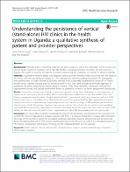| dc.contributor.author | Zakumumpa, Henry | |
| dc.contributor.author | Rujumba, Joseph | |
| dc.contributor.author | Kwiringira, Japheth | |
| dc.contributor.author | Kiplagat, Jepchirchir | |
| dc.contributor.author | Namulema, Edith | |
| dc.contributor.author | Muganzi, Alex | |
| dc.date.accessioned | 2022-01-28T09:32:56Z | |
| dc.date.available | 2022-01-28T09:32:56Z | |
| dc.date.issued | 2018-09-05 | |
| dc.identifier.citation | Zakumumpa, Henry (2018). Understanding the persistence of vertical (stand-alone) HIV clinics in the health system in Uganda: a qualitative synthesis of patient and provider perspectives. Springer nature: BMC Health Services Research.https://doi.org/10.1186/s12913-018-3500-4. | en_US |
| dc.identifier.uri | https://doi.org/10.1186/s12913-018-3500-4 | |
| dc.identifier.uri | https://kyuspace.kyu.ac.ug/xmlui/handle/20.500.12504/323 | |
| dc.description | 13 p. | en_US |
| dc.description.abstract | Although there is mounting evidence and policy guidance urging the integration of HIV services into
general health systems in countries with a high HIV burden, vertical (stand-alone) HIV clinics are still common in
Uganda. We sought to describe the specific contexts underpinning the endurance of vertical HIV clinics in Uganda.
Methods: A qualitative research design was adopted. Semi-structured interviews were conducted with the heads of
HIV clinics, clinicians and facility in-charges (n = 78), coupled with eight focus group discussions (64 participants)
with patients from 16 health facilities purposively selected, from a nationally-representative sample of 195 health
facilities across Uganda, because they run stand-alone HIV clinics. Data were analyzed by thematic approach as
guided by the theory proposed by Shediac-Rizkallah & Bone (1998) which identifies; Intervention characteristics,
organizational context, and broader environment factors as potentially influential on health programme sustainability.
Results: Intervention characteristics: Provider stigma was reported to have been widespread in the integrated care
experience of participating health facilities which necessitated the establishment of stand-alone HIV clinics. HIV
disease management was described as highly specialized which necessitated a dedicated workforce and vertical HIV
infrastructure such as counselling rooms. Organizational context: Participating health facilities reported health-system
capacity constraints in implementing integrated systems of care due to a shortage of ART-proficient personnel and
physical space, a lack of laboratory capacity to concurrently conduct HIV and non-HIV tests and increased workloads
associated with implementing integrated care. Broader environment factors: Escalating HIV client loads and external HIV
funding architectures were perceived to have perpetuated verticalized HIV programming over the past decade.
Conclusion: Our study offers in-depth, contextualized insights into the factors contributing to the endurance of
vertical HIV clinics in Uganda. Our analysis suggests that there is a complex interaction in supply-side constraints
(shortage of ART-proficient personnel, increased workloads, laboratory capacity deficiencies) and demand-side
factors (escalating demand for HIV services, psychosocial barriers to HIV care) as well as the specialized nature of
HIV disease management which pose challenges to the integrated-health services agenda. | en_US |
| dc.language.iso | en | en_US |
| dc.publisher | Springer nature: BMC Health Services Research. | en_US |
| dc.relation.ispartofseries | ;No.690 | |
| dc.subject | Health systems | en_US |
| dc.subject | Service delivery | en_US |
| dc.subject | HIV | en_US |
| dc.subject | Implementation research | en_US |
| dc.subject | Antiretroviral therapy | en_US |
| dc.subject | Integration | en_US |
| dc.subject | Global health initiatives. | en_US |
| dc.title | Understanding the persistence of vertical (stand-alone) HIV clinics in the health system in Uganda: a qualitative synthesis of patient and provider perspectives | en_US |
| dc.type | Article | en_US |

